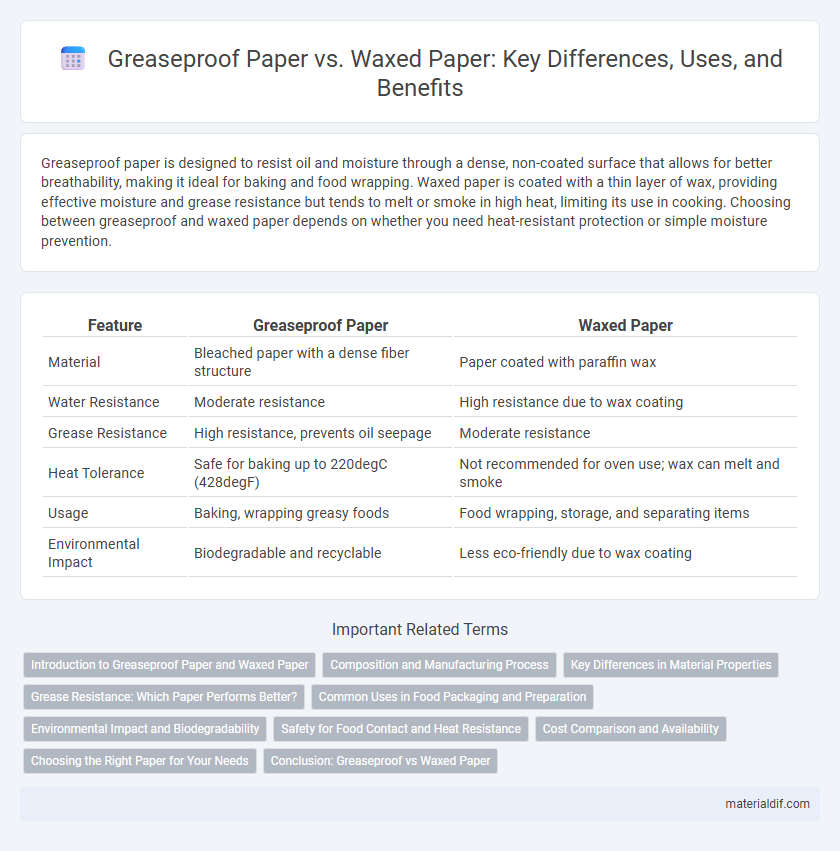Greaseproof paper is designed to resist oil and moisture through a dense, non-coated surface that allows for better breathability, making it ideal for baking and food wrapping. Waxed paper is coated with a thin layer of wax, providing effective moisture and grease resistance but tends to melt or smoke in high heat, limiting its use in cooking. Choosing between greaseproof and waxed paper depends on whether you need heat-resistant protection or simple moisture prevention.
Table of Comparison
| Feature | Greaseproof Paper | Waxed Paper |
|---|---|---|
| Material | Bleached paper with a dense fiber structure | Paper coated with paraffin wax |
| Water Resistance | Moderate resistance | High resistance due to wax coating |
| Grease Resistance | High resistance, prevents oil seepage | Moderate resistance |
| Heat Tolerance | Safe for baking up to 220degC (428degF) | Not recommended for oven use; wax can melt and smoke |
| Usage | Baking, wrapping greasy foods | Food wrapping, storage, and separating items |
| Environmental Impact | Biodegradable and recyclable | Less eco-friendly due to wax coating |
Introduction to Greaseproof Paper and Waxed Paper
Greaseproof paper is a type of paper treated to resist oil and grease, making it ideal for food wrapping and baking applications. Waxed paper is coated with a thin layer of wax, providing a moisture-resistant barrier that prevents food from sticking. Both papers serve distinct roles in kitchen tasks due to their unique properties in oil and moisture resistance.
Composition and Manufacturing Process
Greaseproof paper is made from tightly woven cellulose fibers that undergo a refining process to reduce porosity and increase density, allowing it to resist oil and grease penetration without additional coatings. Waxed paper is produced by impregnating or coating regular paper with paraffin wax or other waxes, creating a moisture-resistant and non-stick surface. The manufacturing of greaseproof paper involves specialized fiber treatments and calendering, while waxed paper manufacturing requires dipping or spraying the paper with molten wax followed by cooling to solidify the coating.
Key Differences in Material Properties
Greaseproof paper is made from highly refined pulp that creates a dense, non-porous surface resistant to oil and moisture, making it ideal for baking and food wrapping without adding a coating. Waxed paper is coated with a thin layer of paraffin wax, providing a moisture and grease-resistant barrier but melting under high temperatures, which limits its use in baking. The key material difference lies in greaseproof paper's natural resistance versus waxed paper's wax coating, affecting durability, heat resistance, and suitability for various kitchen tasks.
Grease Resistance: Which Paper Performs Better?
Greaseproof paper offers superior grease resistance due to its tight fiber structure and lack of coatings, effectively preventing oil and grease from penetrating the paper. Waxed paper, coated with a thin layer of paraffin wax, provides a moisture-resistant barrier but may allow some grease to seep through under high-fat conditions. For applications requiring maximum grease resistance, such as wrapping oily foods or lining baking trays, greaseproof paper performs better by maintaining its integrity and preventing grease leakage.
Common Uses in Food Packaging and Preparation
Greaseproof paper, made from tightly woven fibers, is ideal for baking and wrapping oily foods due to its porous nature that resists grease absorption. Waxed paper, coated with paraffin wax, provides a moisture-resistant barrier commonly used for wrapping sandwiches and lining cake pans to prevent sticking. Both papers serve distinct roles in food packaging and preparation, with greaseproof paper preferred for heat exposure and waxed paper suited for cold and dry applications.
Environmental Impact and Biodegradability
Greaseproof paper is typically made from natural fibers without chemical coatings, making it more environmentally friendly and biodegradable compared to waxed paper, which is coated with paraffin or polyethylene wax derived from petroleum. The biodegradable nature of greaseproof paper ensures faster decomposition and less environmental pollution, while waxed paper's synthetic coating hinders breakdown and contributes to landfill accumulation. Choosing greaseproof paper supports sustainable waste management practices and reduces reliance on non-renewable resources.
Safety for Food Contact and Heat Resistance
Greaseproof paper is made from highly refined cellulose fibers, offering excellent safety for food contact due to its non-toxic, chemical-free composition and high heat resistance, suitable for baking and steaming at temperatures up to 220degC. Waxed paper is coated with paraffin wax, making it moisture-resistant but less heat-tolerant, as the wax can melt or ignite around 120degC, posing potential safety risks during cooking. For direct high-heat applications, greaseproof paper is recommended over waxed paper to ensure food safety and avoid contamination or fire hazards.
Cost Comparison and Availability
Greaseproof paper generally costs less than waxed paper due to its simpler manufacturing process and wider availability in retail and bulk supply stores. Waxed paper, coated with a thin layer of paraffin wax, tends to be pricier and may be less readily accessible in some regions or specialty stores. Both types serve different kitchen purposes, but budget-conscious buyers often prefer greaseproof paper for cost efficiency and ease of purchase.
Choosing the Right Paper for Your Needs
Greaseproof paper is a porous, non-coated paper designed to resist grease and oil penetration, making it ideal for baking and wrapping oily foods. Waxed paper, coated with a thin layer of wax, provides a moisture-resistant barrier suited for food storage and preparation but is not heat-resistant. Selecting the right paper depends on whether you need heat tolerance for cooking or moisture resistance for storage.
Conclusion: Greaseproof vs Waxed Paper
Greaseproof paper offers superior breathability and resists oil penetration without melting, making it ideal for baking and wrapping oily foods. Waxed paper features a waterproof, non-stick surface due to its paraffin coating, suitable for cold food storage but not recommended for high-temperature cooking. Choosing between greaseproof and waxed paper depends on specific culinary needs, with greaseproof favored for oven use and waxed for moisture-resistant food preservation.
Greaseproof paper vs Waxed paper Infographic

 materialdif.com
materialdif.com